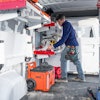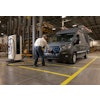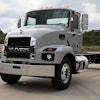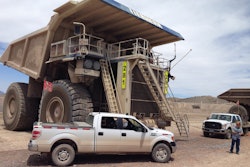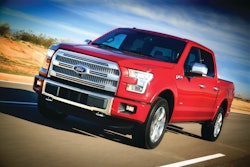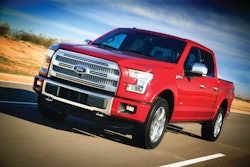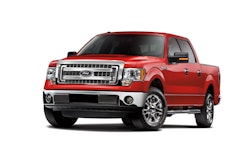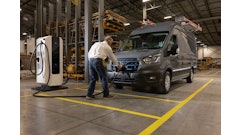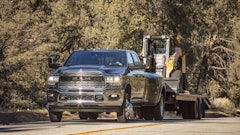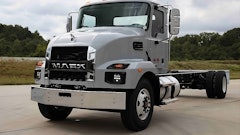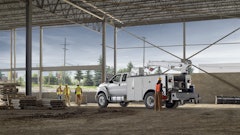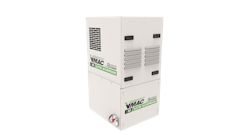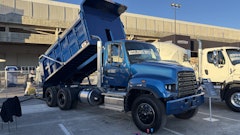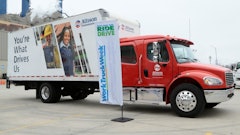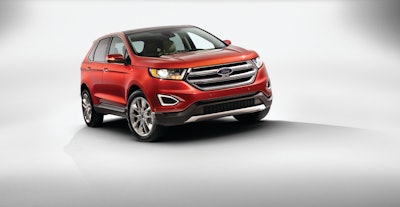
What does a crossover utility vehicle have to do with the truck market? More than meets the eye. The 2015 Ford Edge, introduced last week was packed with new technology, some of which is certain to migrate to Ford's F-150 and other pickup trucks.
One of the most obvious technologies that may soon find its way onto the Ford F-Series trucks is adaptive steering. The 2015 Edge is the first Ford product to feature the technology, which makes the vehicle easier to maneuver and more fun to drive.
A standard feature on Edge Sport and available on the new Titanium series, adaptive steering changes the ratio between a driver’s actions at the steering wheel – the number of turns – and how much the front wheels turn. In traditional steering systems, this is a fixed steering ratio. Ford's adaptive steering continually changes the ratio as vehicle speed changes, optimizing response in all situations.
At lower speeds, such as pulling into a parking space or maneuvering in tight quarters, the new system makes the vehicle more agile by angling the front wheels more with each turn of the steering wheel. Low-speed maneuvers require less turning of the steering wheel.
The system enables Edge to react more smoothly and precisely to driver input at highway speeds by reducing the degree of response to the steering wheel.
The Ford system uses a precision-controlled actuator placed inside the steering wheel, and requires no change to the vehicle’s traditional steering system. The actuator – an electric motor and gearing system – can essentially add to or subtract from a driver’s steering inputs. The result is a better, more engaging driving experience at all speeds.
Engine enhancements for EcoBoost
The 2015 Edge will feature enhancements to its EcoBoost engines. The first is a new twin-scroll 2.0-liter EcoBoost four-cylinder engine that will be standard. The twin-scroll 2.0-liter EcoBoost, offering an estimated 245 horsepower and 270 lb.-ft. of torque, is significantly improved over the previous 2.0-liter EcoBoost. Beyond efficiency advantages, this new engine will also provide more capability.
The twin-scroll design enables optimized camshaft timing for improved engine performance and reduced turbo lag. A new, lighter engine block casting along with new aluminum balance shaft assembly shaves six pounds from the engine’s gravitational weight. Other changes include lighter pistons; a newly designed, integrated exhaust manifold; and a new, high-pressure direct-injection fuel system for finer fuel atomization. These upgrades pave the way for an increased compression ratio of 9.7:1, up from 9.3:1, for improved overall fuel efficiency.
Ford’s Auto Start-Stop system will also be available with the twin-scroll EcoBoost engine on the new Edge. In heavy traffic, this technology can seamlessly shut down the engine to decrease fuel consumption, reducing tailpipe emissions to zero while the vehicle is stationary and the engine is off.
Could the twin-scroll design or Auto Start-Stop be adapted for pickup truck applications? We will have to wait and see.
Finally, Ford displayed enhancements to its 2.7-liter EcoBoost which is expected to deliver more than 300 horsepower.
The 2.7-liter EcoBoost uses the same compacted graphite iron in its cylinder block as is used in the 6.7-liter Power Stroke. This advanced cylinder block allows for a remarkably stiff and compact design that returns exceptionally refined noise, vibration and harshness control. The compacted graphite iron core is mated with a die-cast aluminum engine-block ladder frame and composite oil pan, saving weight by applying advanced materials where they are needed most.
The strength of the compacted graphite iron cylinder block allows the 2.7-liter EcoBoost engine to produce impressive power and torque for its size. Compact and efficient, the all-new engine can produce the power and torque of a mid-range V8.
Other technologies on the 2015 Ford Edge that have potential applications for future pickup trucks include:
- Active Grille Shutters: available on select models to help reduce air resistance
- Adaptive cruise control and collision warning with brake support: uses radar to detect moving vehicles directly ahead and change cruising speed if necessary to maintain safe distance
- Auto Start-Stop technology: turns the engine off to save fuel when the vehicle is stopped, then restarts the engine in milliseconds when the brake is released
- Blind Spot Information System (BLIS): uses radar to trigger a warning when another motorist is in the driver’s blind spot
- Cameras: new 180-degree front camera with washer featured for first time on a Ford vehicle; standard rear camera
- Cross-traffic alert: uses radar to help alert drivers to oncoming traffic when backing out of a parking space
- Curve Control: uses the same sensors as Roll Stability Control to detect and measure roll rate, yaw rate, lateral acceleration, wheel speed and steering-wheel angle to help drivers follow their intended path by slowing the vehicle more efficiently while maneuvering a curve
- Enhanced active park assist: builds on Ford parallel parking technology and includes a system to guide the vehicle into a perpendicular parking space. The system can also steer the vehicle into and out of a parallel parking space
- Forward and reverse sensing systems: the systems provide audible alerts designed to help drivers avoid obstacles when parking
- Heated and cooled front seats, heated rear seats, heated steering wheel: amenities make occupants more comfortable
- Lane-keeping system: alerts driver to steer the vehicle back into its lane if the vehicle is allowed to drift
- Side parking sensors: uses sensors and algorithms that measure speed and steering wheel angle to warn drivers of obstacles on either side of the vehicle during parking or low-speed maneuvers
